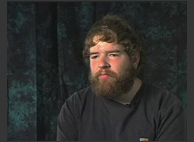| NIMH: Autism Spectrum Disorders | |
| NICHD: Autism and the MMR Vaccine | |
| Richard, Age 52 | |
| Jeff, Age 35 | |
| NIMH: Autism Spectrum Disorders (pdf) | |
| CDC: Learn the Signs Information Card (pdf) | |

Causes
- Causation of autism is unknown
- Strong genetic influence
- Evidence supports polygenic inheritance
- Recurrence risk is 5-8% in siblings
Autism does NOT result from:
- Poor parenting
- MMR vaccine
- Thimerosal preservative in vaccines
Research into the causes, the diagnosis, and the treatment of autism spectrum disorders has advanced in tandem. With new well-researched standardized diagnostic tools, ASD can be diagnosed at an early age. And with early diagnosis, the treatments found to be beneficial in recent years can be used to help the child with ASD develop to his or her greatest potential.
In the past few years, there has been public interest in a theory that suggested a link between the use of thimerosal, a mercury-based preservative used in the measles-mumps-rubella (MMR) vaccine, and autism. Although mercury is no longer found in childhood vaccines in the United States, some parents still have concerns about vaccinations. Many well-done, large-scale studies have now been done that have failed to show a link between thimerosal and autism. A panel from the Institute of Medicine is now examining these studies, including a large Danish study that concluded that there was no causal relationship between childhood vaccination using thimerosal-containing vaccines and the development of an autism spectrum disorder,28 and a U.S. study looking at exposure to mercury, lead, and other heavy metals.
Because of its relative inaccessibility, scientists have only recently been able to study the brain systematically. But with the emergence of new brain imaging tools—computerized tomography (CT), positron emission tomography (PET), single photon emission computed tomography (SPECT), and magnetic resonance imaging (MRI), study of the structure and the functioning of the brain can be done. With the aid of modern technology and the new availability of both normal and autism tissue samples to do postmortem studies, researchers will be able to learn much through comparative studies.
Research into the causes of autism spectrum disorders is being fueled by other recent developments. Evidence points to genetic factors playing a prominent role in the causes for ASD. Twin and family studies have suggested an underlying genetic vulnerability to ASD.30 To further research in this field, the Autism Genetic Resource Exchange, a project initiated by the Cure Autism Now Foundation, and aided by an NIMH grant, is recruiting genetic samples from several hundred families. Each family with more than one member diagnosed with ASD is given a 2-hour, in-home screening. With a large number of DNA samples, it is hoped that the most important genes will be found. This will enable scientists to learn what the culprit genes do and how they can go wrong.
Another exciting development is the Autism Tissue Program (http://www.brainbank.org), supported by the Autism Society of America Foundation, the Medical Investigation of Neurodevelopmental Disorders (M.I.N.D.) Institute at the University of California, Davis, and the National Alliance for Autism Research. The program is aided by a grant to the Harvard Brain and Tissue Resource Center (http://www.brainbank.mclean.org), funded by the National Institute of Mental Health (NIMH) and the National Institute of Neurological Disorders and Stroke (NINDS). Studies of the postmortem brain with imaging methods will help us learn why some brains are large, how the limbic system develops, and how the brain changes as it ages. Tissue samples can be stained and will show which neurotransmitters are being made in the cells and how they are transported and released to other cells. By focusing on specific brain regions and neurotransmitters, it will become easier to identify susceptibility genes.
NIMH



